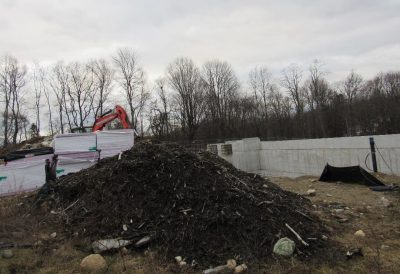Contaminated Water Found in PV Home Wells in Ongoing Investigations
News Based on facts, either observed and verified directly by the reporter, or reported and verified from knowledgeable sources.

Putnam Valley property owners have been notified by two state agencies that their drinking water wells are contaminated with Polyfluoroalkyl substances (PFAS) at levels measuring above the maximum contaminant level (MCL).
The state Department of Environmental Conservation (DEC) and Department of Health (DOH) concluded that the drinking water at an undisclosed number of homes that exceeded New York’s MCL of 10 parts per trillion (ppt). Both agencies, which did not respond to inquiries about how many residences were affected, initiated a private well evaluation in Putnam Valley earlier this year.
The two departments also did not respond to what the range in MCLs at the affected properties.
“The evaluation was to assess and take action to protect the public from potential exposure to contaminants,” stated a DEC correspondence. “To date, detections exceeding the State’s stringent standards for drinking water were found at 10 locations and property owners were provided an alternate drinking water supply. Private well sampling is ongoing.”
Letters to homeowners from the DOH last month stated that the ongoing environmental investigation of the Putnam Valley Volunteer Fire Department (PVVFD) led to the sampling of water in the area.
Most homeowners who had received the letter refused to comment to The Examiner.
Putnam Valley property owners whose well water was found to be contaminated live in a densely populated area that includes Kramers Pond Road, Harimac Road, Dogwood Lane and Briar Ridge Lane, an area downhill and at least a half-mile from the fire department’s 10-acre landfill on Oscawana Lake Road.
It is the same site that was contaminated in 2016 when 17,000 cubic yards of contaminated fill and hazardous materials were dumped. The PVVFD paid a $5,000 fine to the DEC in 2019 for illegally operating a solid waste management facility. In 2020, a year-long remediation project commenced, costing taxpayers $1.4 million. Currently there is construction at that site for the PVVFD’s new $11 million firehouse.
The issue of the 2016 dumping has become central to ongoing multiple lawsuits involving the fire department, the town and businesses engaged in the dumping.
Last year PFAS contaminants were found in residential drinking water at Floradan Estates, also downhill from the fire department construction site.
The current water contamination investigation is part of the state’s Inactive Landfill Initiative, a state program established in 2017 to investigate and remediate solid waste sites that may be impacting or contaminating drinking water supplies.
Last July’s Status Report for the DEC’s NYS Inactive Landfill Initiative shows that recommendations include pending groundwater investigations for the fire department landfill.
The DEC confirmed offering homeowners who have contaminated wells bottled water for four weeks as well as installing water filtration systems. Ten property owners accepted the offer of bottled water and six of those 10 owners accepted DEC’s offer to install, monitor and maintain Point of Entry Treatment (POET) systems.
POET systems are designed to filter and disinfect ground or well water using granular activated carbon (GAC) and an ultraviolet (UV) unit to disinfect the water before it flows directly into the existing plumbing for use within the residence or commercial building.
The DEC said installation of the POET water filtration system is currently being coordinated with the Putnam Valley property owners.
“A second round of private well sampling by the DEC in partnership with DOH, in the area was recently completed, the DEC noted. “The data will be evaluated to determine if additional sampling is necessary.”
Residents were asked by the DEC to sign an agreement consenting to the POET installation and to be responsible to monitor the system once installed.
Shawn Rogan, director of environmental health at Putnam County’s Department of Health, said his department was not directly involved in the state’s Inactive Landfill Initiative but they are in communication with the state regarding residents’ concerns.
“We have strongly advocated for both DOH and DEC investigations to continue their investigation into the Orlando Landfill as well as the impacts of the contaminated fill associated with the Putnam Valley Fire Department site,” Rogan said.
The Orlando Landfill is also on Kramers Pond Road and was listed by the federal Environmental Protection Agency (EPA) as a superfund site but has since been fully remediated.
Rogan also said Putnam Valley residents contacted by the DEC and DOH about their well water results would decide what actions, if any, would take place.
“Well water testing results would indicate one of three possible outcomes: no further action, resampling is indicated, or detection of chemicals suggesting area groundwater impacted by a potential nearby source that may or may not be associated with the referenced (fire department) landfill,” he said.
DEC letters to homeowners also made clear that if the property was put on the market or sold, New York State Real Property Law stipulates that owners first sign a disclosure statement acknowledging that testing for water contamination was done and provide results of the testing.
One affected homeowner who did respond, Harimac Road resident Tom McShane, said he got a call on Monday confirming toxins in his well.
“The DEC will be getting in touch with me next,” McShane said. They’ll be providing water for us at no charge. I’m upset. I feel the value of my house just sunk.”
An updated 2024 study by the National Bureau of Economic Research about the impact of unregulated contaminants on housing prices showed that high-profile media coverage about PFAS contamination significantly decreased property values of affected homes and that there was “no rebound in property values after the contaminated source well was moved offline.”
PFAS substances can accumulate over time in the environment and in the bodies of animals and people, posing health risks including kidney and testicular cancer, liver and thyroid problems, reproductive issues, pregnancy-induced high blood pressure, low birth weight and increased risk of birth defects, among other impacts.
In 2020, New York State lowered the MCL for PFAS from 70 to 10 ppt. Stricter levels were announced last month by the EPA for the first-ever federal limits on toxic PFAS in drinking water, establishing a MCL of 4 parts ppt for the two most widely detected PFAS chemicals, PFOA and PFOS.
Correction: In the original version of this article Tom McShane’s street of residence was misidentified. The Examiner regrets the error.

Abby is a local journalist who has reported on breaking news for more than 20 years. She currently covers community issues in The Examiner as a full-time reporter and has written for the paper since its inception in 2007. Read more from Abby’s editor-author bio here. Read Abbys’s archived work here: https://www.theexaminernews.com/author/ab-lub2019/
